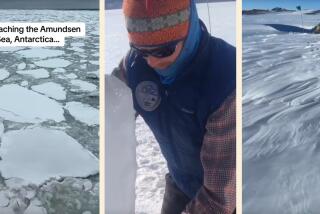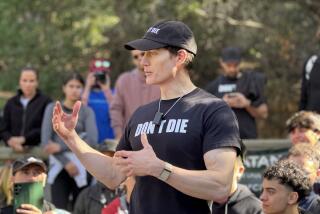Neil deGrasse Tyson to lead viewers on ‘Cosmos: A Spacetime Odyssey’
- Share via
NEW YORK — Bringing a long list of prepared questions to an interview with Neil deGrasse Tyson is a fool’s errand. That’s not to say a conversation with the director of the Hayden Planetarium at the American Museum of Natural History isn’t illuminating — quite the opposite.
It’s just that the gregarious astrophysicist can’t help but find science lurking in every corner, turning even the most banal transaction into a teaching moment. An offer of bottled water, for instance, unexpectedly turns into a lengthy digression about the difficulty of freezing distilled water and the origins of Gatorade.
Tyson’s zeal for knowledge is intoxicating and irresistible, even if it means less time for the ostensible topic of the conversation — his starring role in the documentary series “Cosmos: A Spacetime Odyssey,” premiering on Fox and National Geographic in March.
“I see myself as a servant of the public appetite for the universe,” says Tyson, seated in his office overlooking the giant white sphere of the Hayden Planetarium.
Scattered among hundreds of astronomy books are, among other things, a vanity plate reading “COZMIC,” a life-sized bust of Sir Isaac Newton, a half-dozen or so globes, a quill pen collection, a can of Dole pineapples in “cosmic fun shapes” and a pink boa.
Tyson’s combination of humor, intelligence and accessibility have made him one of the most recognizable scientists in the country and put him atop many fantasy dinner-party guest lists. The author or editor of 10 books, he maintains an active social media presence (1.5 million Twitter followers) and produces a radio show and podcast, “StarTalk Radio.” He’s also become a late-night TV regular, through frequent visits to “The Daily Show,” “The Colbert Report” and “Real Time With Bill Maher.”
Now he’s moving into prime time with “Cosmos,” a follow-up to Carl Sagan’s groundbreaking 1980 PBS series, “Cosmos: A Personal Voyage.” In what may seem like an odd pairing, Seth MacFarlane serves as executive producer on the series. Tyson first met the “Family Guy” creator at a gathering of the Science and Entertainment Exchange in Los Angeles several years ago and later pitched him about getting involved in a “Cosmos” reboot.
BEST TV OF 2013 Lloyd | McNamara
“Neil has an ability to connect,” says Ann Druyan, Sagan’s widow and co-writer with Steven Soter of all 13 episodes of the new “Cosmos.” “In his indefatigable energy, his incredible goodwill and good humor, and his humility, he reminds me so much of Carl.” The original documentary was notable for its formal innovations, ditching the talking-head style for a more cinematic feel achieved through then-cutting-edge special effects. The reimagined “Cosmos” will do the same, with Tyson moving through space and time in a “Spaceship of the Imagination.” (He will not, however, do so wearing a turtleneck.)
The 55-year-old Bronx native discovered his passion for space on a visit to the Hayden Planetarium at age 9. “I’m quite sure it was the universe that chose me and not I who chose it,” he has said. By the time he was a student at the prestigious Bronx High School of Science, he was giving astronomy lectures to adult-education classes.
When Tyson was applying to college, Sagan, then a faculty member at Cornell, gave him a personally guided tour of his laboratory to lure him to the school. But Tyson opted for Harvard instead and later pursued a PhD at Columbia. After publishing his first book, “Merlin’s Tour of the Universe,” he joined the staff at the Hayden Planetarium. In 1995 he gave an interview to an NBC News crew about the discovery of a new planet; the experience made him determined never to be “sound bitten” again.
He began working on his own sound bites in front of the mirror, picking a subject — say, black holes — and coming up with “three or four sentences that would be tasty, interesting, informative and make you smile.”
PHOTOS: Faces to watch 2014 | TV
The practice clearly paid off, with Tyson’s media presence steadily growing. He hosted the PBS series “Nova ScienceNow” for five years and has made cameos on “The Big Bang Theory” and “Stargate Atlantis.”
“The great thing about having Neil as a guest is that he’s not only informed and enthusiastic, he burns before you,” says Stephen Colbert in an email. “He kindles everyone’s interest in the subject he’s talking about. I feel vaguely singed on the side of my body that faces Neil during the interview, and afterwards I have to check my eyebrows to make sure they’re both still there.”
Tyson has also become a kind of geek hero online, participating in four hugely popular “Ask Me Anything” sessions for the social news site Reddit and inspiring dozens of memes and GIFs. “If I am an ambassador, it’s not because I sought it out, it’s because people made me one,” he says as he opens a folder on his computer where he’s saved fan-generated Internet ephemera, including manipulated images of him twerking with Miley Cyrus and leaning in for a kiss from Sagan.
“I think people respond to a certain gestalt of this upbeat, friendly, funny guy. He’s not a snob. He really tries to get down to wherever you are and just hang out with you intellectually or verbally,” says Avis Lang, his longtime editor and collaborator. She shares an evocative story about how Tyson lifted a young fan, perhaps 10 or 11 years old, on stage at the annual Isaac Asimov lecture at the Museum of Natural History.
PHOTOS: Celebrities by The Times
“He just picked the kid up and put him on the stage so that he could say his piece,” she recalls.
Tyson sees his growing fame as a way to advocate for renewed federal investment in space exploration, particularly a manned mission to Mars and asteroid-deflection technology, at a time when NASA is viewed by some as an extravagant relic of the Cold War. “If the public likes what you do and they understand what you do, then they’re more likely to put political pressure on lawmakers to support what you’re doing, and that support enables the field to thrive,” he reasons.
As well-liked as he is, Tyson also has a pronounced contrarian streak and delights in playing pop-culture nitpicker. He has tried to get Jon Stewart to correct the counterclockwise-spinning globe in the opening credits of “The Daily Show.” More successfully, he lobbied for James Cameron to alter the stars in the 3-D release of “Titanic” to accurately reflect the night skies of the North Atlantic in April 1912. And in a widely circulated series of tweets last fall, he pointed out numerous inaccuracies in the space disaster film “Gravity.” (“Mysteries of #Gravity: Why Bullock’s hair, in otherwise convincing zero-G scenes, did not float freely on her head.”)
Tyson’s sticklerism also extends to his work at the planetarium, which, under his direction, became one of the first scientific institutions in the country to downgrade Pluto to status as a dwarf planet. The decision provoked the ire of elementary schoolers across the country and hastened Pluto’s official reclassification in 2006 by the International Astronomical Union.
“Cosmos,” which Tyson filmed over six months in 30 locations around the globe, further accelerated an already manic schedule. “It’s always out of balance,” he says. “Let’s make that clear.”
Married with two teenage children, Tyson is working on another book with Lang and continues to give lectures around the country nearly every weekend.
“After ‘Cosmos,’ I have the delusional idea that maybe I’ll become a scientist again rather than only playing one on TV,” says Tyson. “I’ve had people call me up and say, ‘Who’s your agent who gets you on all these shows?’ My agent is the universe.”
More to Read
The complete guide to home viewing
Get Screen Gab for everything about the TV shows and streaming movies everyone’s talking about.
You may occasionally receive promotional content from the Los Angeles Times.







